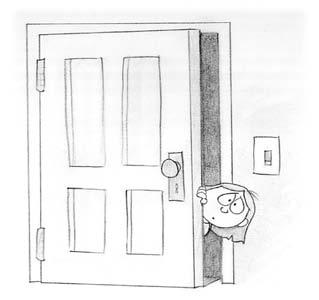The 1-2-3 Magic Workbook for Christian Parents: Effective Discipline for Children 2-12 (27 page)
Read The 1-2-3 Magic Workbook for Christian Parents: Effective Discipline for Children 2-12 Online
Authors: Thomas W. Phelan,Chris Webb
Tags: #Family & Relationships, #Parenting, #General

mouth must be something positive
—some type of praise. You might, for
instance, simply praise the child for remembering to show you her work.
After saying something nice about the child’s effort, you may then make
a negative comment, if it’s absolutely necessary. Finally, you conclude
your insightful remarks with something positive again. So the procedure
is Positive-Negative (if necessary)-Positive.
Using the spelling pretest as an example, you might first say some-
thing like, “Gee, you spelled ‘consideration’ correctly. That’s a pretty hard
word. And you also got ‘appearance’ right. That’s another long one! In
fact, there’s only one word on here that I can see you didn’t get. Not bad
at all.” You might stop here and try to kill your daughter with suspense.

150 1-2-3 MAGIC
See if she’s dying to find out what the wrong word is. If she’s not, you
can tell her. End the conversation with another positive comment.
Remember the rule: Every time she brings you some work to check,
the first thing you say must be positive. That type of response will help
bring her back again and again. Kids will never want to bring you any-
thing if you follow your natural human inclinations and shoot from the
hip with criticism.
The Rough Checkout
Our next idea, the Rough Checkout, will also help to make your evenings
a lot more pleasant. The Rough Checkout notion is based on the fact that
8:00 in the evening is no time for scholastic perfection. You have worked
all day, and your child has also put in just about the equivalent of a day
on a full-time job—before she even started her homework!
Unless there is some major indication to the contrary, if your
daughter’s schoolwork is anywhere near 80 percent neat, correct and
thorough, consider calling it a day and consider the job done. Let your
youngster and teacher continue worrying about the assignment
tomorrow if they want to.
Quik Tip…
This advice is doubly true for ADD or LD
The first thing out
children who are already having a tough enough
of your mouth
time with school. You can also adjust your Rough
when your child
shows you her homework
Checkout criteria to your child’s overall achieve-
must be something
ment level. If, for example, your child is general y
positive—even if it’s just
an excellent student (A-B average), you might
that she brought her work
to you. And remember:
consider raising the required neat, correct and
8:00 p.m. is no time for
thorough percentage to 90 or more.
academic perfection!
I learned this advice the hard way. A
mother once came into my office reporting that
her twelve-year-old son was getting more depressed, more irritable and
more distant from everyone in the family. It turned out that homework
was a major problem for this boy every night. The lad would finish his
assignments and bring them to his father for checkout. That was the good
news. The bad news was that if the work was not absolutely perfect, Dad
would tear it all up and make his son start over!
HOMEWORK AND PRACTICING 151
When asked how many times—on the average—the Dad was tearing
up the kid’s homework, the mother said about three times per evening.
No wonder the boy was getting demoralized.
I insisted on seeing the father. Dad blustered into the office insisting
that his son was going to learn to do things right the first time and that
he should try to be the best, etc., etc. I replied that the boy was indeed
learning a lot: He was learning to hate schoolwork, to hate his father, to
hate evenings and to hate himself. I further added that if this nightly rou-
tine was continued, it would produce a high school dropout within four
years. The father—somewhat reluctantly—agreed to stop his ridiculous
and tyrannical homework procedure. That was the end of that and, not
surprisingly, this father also started enjoying his evenings more.
So, if your youngster’s work is by far mostly neat, correct and
complete—but not perfect—consider the PNP procedure. Don’t tell the
child, of course, that his schoolwork is superb, because it’s not. Just say
that the work is good and praise some specific parts of what he has done.
Perfectionist parents who squirm at this suggestion need to stay in touch
with the emotional realities of childhood.
Charting for Homework
A daily charting system can be a godsend when it comes to improving
academic work and decreasing homework hostilities. This is especially
true when charting is combined with the Rough Checkout and Positive-
Negative-Positive methods and when spur-of-the-moment homework
requests are avoided. Here’s an easy arrangement that can be used.
Since it’s usually the older kids who have trouble with homework,
a five-point scale instead of stickers can be used on the chart. Five is the
highest mark and one is the lowest mark. A child can earn one point for
each of the following things:
• Neat:
1 point
• Correct:
1 point
• Thorough:
1 point
• No complaining:
1 point
• Starting on your own at the right
time without being reminded:
1 point
Total possible score:
5 points

152 1-2-3 MAGIC
The kids can get each of the first three points by doing better than
whatever approximate percentage of neatness, correctness and complete-
ness you have required according to your Rough Checkout rules. The
no-complaining point is earned if the youngster doesn’t whine or grouse
about having to do his schoolwork.
The last point is the crucial one. We sometimes cal the fifth point the
Magic Point, because if you can get a child to start his work on his own, in a
timely fashion and without being reminded, the bat le is more than half won!
You can also set up friendly incentive games with
Quik Tip…
this last Magic Point. For example, three days
When charting
in a row of starting on your own at the proper
homework
time earns a bonus point. Or starting more than
performance using our
fifteen minutes early and finishing in a reasonable
5-point system, the fifth
point is the Magic Point.
amount of time earns two bonus points.
A child earns the fifth
Put on your thinking cap and see what other
point for starting his
schemes you can come up with. The possibili-
schoolwork at the right
ties are endless, and playing around with the
time without being
reminded. That’s half the
Magic Point helps accomplish the impossible—
battle!
making homework more fun.
Remember that for many kids with aca-
demic handicaps, you may very well have to use artificial reinforcers to
help motivate the child over the homework hurdle. Your successful young
scholar, for example, might earn a special outing with you, a special meal,
part of his allowance, or time on a new game for posting a certain num-
ber of points during the week. Different rewards may require different
numbers of points. Check back to our list of rewards on pages 122-123.
Also, don’t forget that kitchen timer when dealing with homework.
For instance, it can be used to help break up the work into smaller,
manageable fifteen-to-twenty-minute pieces. A timer also helps keep kids
on task. If your child complains that the timer’s ticking bothers him, use
some kind of sand hourglass or a quiet electric or LCD device.
Practicing
When I was young my parents required that I take music lessons from
time to time. As you can easily imagine, one of my least favorite

HOMEWORK AND PRACTICING 153
memories is having to come in from playing baseball out in the street
in order to practice the piano or clarinet. So here’s a warning to all you
parents from a former kid:
Sophisticated and well-conceived parenting
technology is necessary to get children to practice regularly
.
The tactics for getting kids to practice follow the same logic as
those for homework. Avoid spontaneous requests and consider natural
consequences first if a child is just starting out. Some of these music
teachers are downright scary, and many children would not dare come to
their lesson unprepared. If natural consequences don’t work, try charting
with or without artificial rewards.
The PNP method also applies to practicing. Make sure your comments
start with positive reinforcement, add negative remarks if it’s absolutely
necessary, then conclude with the positive again.
Charting also can help a lot with practicing. For some kids just put-
ting on the chart the number of minutes they practiced can be enough to
keep them going. For others, artificial reinforcers may be necessary. Keep
in mind that points for not complaining and—especially—for starting
on your own without being reminded are very helpful. We’re trying to
reinforce not only musical ability but also attitude.
Now that the homework and practicing are out of the way, it’s time
for bed!
Homework Helpers
1. Routine is CRITICAL!
2. Natural consequences
3. The Positive-Negative-Positive (PNP) Method
4. The Rough Checkout
5. Charting

18
Bedtime and Nighttime Waking